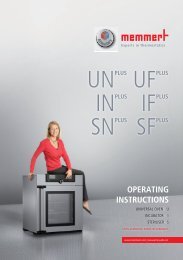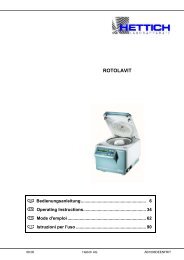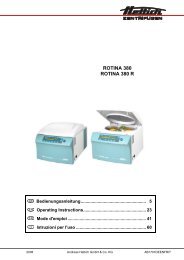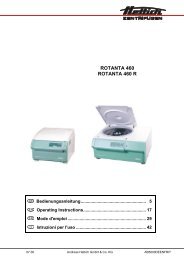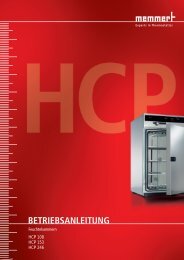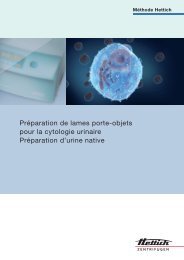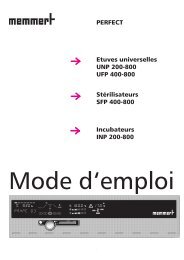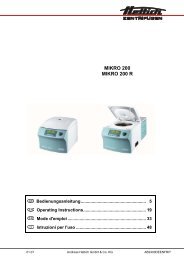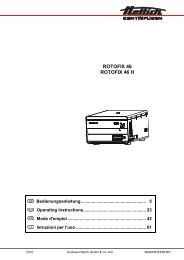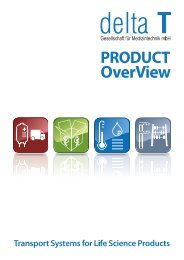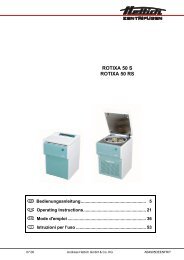ROTOFIX 32 A - Hettich AG, CH
ROTOFIX 32 A - Hettich AG, CH
ROTOFIX 32 A - Hettich AG, CH
You also want an ePaper? Increase the reach of your titles
YUMPU automatically turns print PDFs into web optimized ePapers that Google loves.
20.2 Rotors and Attachments<br />
• In order to prevent corrosion and material changes, rotors and accessories must be cleaned regularly with soap<br />
or a mild detergent and a damp cloth. Cleaning is recommended at least once a week, even better after every<br />
usage.<br />
• If the rotor or accessory parts are contaminated by pathogenic or radioactive material, a suitable cleaning has to<br />
be executed. For disinfection we recommend Helipur ® H plus N from the company B. Braun Melsungen. For the<br />
removal of radioactive material we recommend decon neutracon ® from the company Decon Laboratories<br />
Limited.<br />
• The rotors and accessory parts must be dried immediately after cleaning.<br />
• Angle rotors, container and hanger made of aluminium are to be lightly greased after drying using acid-free<br />
grease, e.g. vaseline.<br />
• With aerosol-sealed rotors and bio safety systems (see Chapter "Anhang/Appendix, Rotoren und<br />
Zubehör/Rotors and accessories") the sealing rings are to be checked and cleaned regularly (weekly). The<br />
sealing ring is to be replaced immediately upon indication of crack formation, embrittlement or abrasive wear. To<br />
prevent the sealing ring from twisting when the lid is opened and closed, the sealing ring must be lightly greased<br />
with acid-free grease, such as Vaseline.<br />
• In order to prevent corrosion as a result of moisture between the rotor and the motor shaft, the rotor should be<br />
disassembled and cleaned at least once a month, and the motor shaft should be lightly greased.<br />
• The rotors and accessory parts are to be checked on a monthly basis for corrosion damage.<br />
Rotors and attachments may no longer be utilised upon indication of wear and tear or corrosion.<br />
• Check the firm seating of the rotor on a weekly basis.<br />
20.2.1 Trunnions<br />
With swing-out rotors the trunnions must be regularly lubricated (<strong>Hettich</strong> Lubricating Grease No. 4051) in order to<br />
ensure consistent swinging out of the hangers.<br />
20.2.2 Rotors and accessories with limited term of use<br />
The use of specific rotors, suspensions and accessories is time limited.<br />
They are marked with an expiry date, e.g. "einsetzbar bis Ende: / usable until end of: ΙV. Quartal 2011" (applicable<br />
until the end of: ΙVth quarter 2011).<br />
The rotors, suspensions and accessories may not be used for longer periods for safety reasons once the<br />
marked expiry date has been reached.<br />
20.3 Autoclaving<br />
Swing-out rotors, angle rotors made of aluminium, suspension made of metal, lids with biodegradable seals as well<br />
as stands and reductions can be autoclaved at 121° C / 250°F (20 mins).<br />
Otherwise you must ask the manufacturer.<br />
The lids of the rotors and containers must be removed prior to autoclaving.<br />
Autoclaving accelerates the ageing process of plastics. In addition, autoclaving may discolour plastics.<br />
After autoclaving, we recommend that the sealing rings of the aerosol-tight and bio-safety systems be<br />
exchanged.<br />
20.4 Centrifuge containers<br />
• With leakiness or after the breakage of centrifuging containers broken container parts and leaked centrifugation<br />
material are to be completely removed.<br />
• The rubber inserts as well as the plastic sleeves of the rotors are to be replaced after a glass breakage.<br />
Remaining glass splitters cause further glass breakage!<br />
• If this concerns infectious material, a disinfection process is to be executed immediately.<br />
EN<br />
27/72



